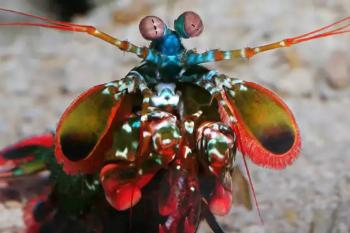Includes: Crustaceans, Spiders, and Insects
Of the roughly one-and-a-quarter million named animals species, over one million are arthropods. These animals occupy by far the widest variety of habitats on earth.
The name arthropod means ‘jointed foot.’ All arthropods have segmented bodies and are covered in a jointed, protective armor called an exoskeleton. Their body muscles attach to the inside of the exoskeleton. In order to grow, arthropods must periodically molt—a process that entails shedding their exoskeleton and inflating their body before the new skeleton hardens.
The incredible diversity and success of the arthropods can be attributed to their extraordinarily adaptable body plan. A key feature is the evolution of myriad types of appendages (antennae, claws, wings, mouth parts) that allow arthropods to exploit nearly every niche on earth.
For hundreds of millions of years, animal life resided only in the oceans. Then about 400 million years ago fossil tracks suggest that an arthropod left the water to walk on land. Arthropods invaded land many times. Fossil evidence shows that different groups including insects, millipedes and centipedes, spiders and scorpions—all came ashore on their own at different times.
Features:
- Hard exoskeleton made of chitin and protein
- Possess numerous jointed appendages and a segmented body
- Must molt to grow
Arthropod fact:
The fastest flying insects can travel at up to 35 miles per hour.
Word Bank
Exoskeleton: a rigid, outside covering that provides structural support and gives muscles something to pull against
Chitin: a substance that provides a tough, protective covering; similar to keratin, the substance that human hair and nails are made from
Niche: the role or function of an organism in an ecosystem
















